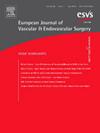advantage V12或iCAST桥式支架用于开窗和分支血管内主动脉修复的系统评价和meta分析
IF 5.7
1区 医学
Q1 PERIPHERAL VASCULAR DISEASE
European Journal of Vascular and Endovascular Surgery
Pub Date : 2025-04-01
DOI:10.1016/j.ejvs.2025.01.004
引用次数: 0
摘要
目的:开窗和分支血管内主动脉修复(FB-EVAR)术后再介入治疗有一半与靶血管相关。关于桥接支架的选择,现有数据存在争议。本荟萃分析旨在评价Advanta V12/iCAST作为桥接支架在FB-EVAR中的性能。数据来源:通过MEDLINE、Embase(通过Ovid)和Cochrane数据库检索英文医学文献(截止日期为2024年4月15日)。综述方法:系统评价和荟萃分析(PRISMA)指南和PICO (Patient;干预;比较;结果)模型。一个预定义协议注册到PROSPERO (CRD42024556603)。报告Advanta V12/iCAST相关靶血管结果的随机对照试验和观察性研究(2010 - 2024)符合条件。使用ROBINS-I评估偏倚风险,通过推荐评估、发展和评价分级(GRADE)评估证据质量。主要结果是无不稳定、狭窄和/或闭塞、Ic型和IIIc型内漏,以及用Advanta V12/iCAST桥接的靶血管的再干预。进行患病率和回归meta分析。结果:1 439篇文章中,10项回顾性研究(7 525例靶血管;采用adva V12/iCAST桥接的靶血管共3890条。根据ROBINS-I,没有高质量的研究。平均随访时间为24.3个月(95%可信区间[CI] 23.9 ~ 24.7)。无不稳定、狭窄和/或闭塞、Ic型和IIIc型内漏的94% (95% CI 91 - 96%;P 2 = 91%;GRADE确定性,非常低),97% (95% CI 96 - 98%;P =。070, i2 = 44%;GRADE确定性,低)和97% (95% CI 94 - 98%;P 2 = 81%;GRADE确定性,非常低)。靶血管再干预自由度为95% (95% CI 92 - 97%;P 2 = 85%;GRADE确定性,非常低)。四项研究在开窗和四项分支中提供了Advanta V12/iCAST的可提取数据。在不稳定自由度(p = 0.47)、狭窄和/或闭塞自由度(p = 0.36)和内漏型Ic和IIIc (p = 0.90)方面均无差异。再次干预的自由度为93% (95% CI 87 - 96%;p 2 = 90%)和95% (95% CI 91 - 97%;P =。060, I2 = 64%)。结论:爱德华V12/iCAST桥接支架具有良好的抗靶血管不稳定、抗狭窄/闭塞、抗内漏等特点。再次干预的自由度为95%,在开窗和分支中同样很高。本文章由计算机程序翻译,如有差异,请以英文原文为准。
Systematic Review and Meta-analysis of Outcomes of the Advanta V12 or iCAST Bridging Stent Graft Used for Fenestrated and Branched Endovascular Aortic Repair
Objective
Half of re-interventions after fenestrated and branched endovascular aortic repair (FB-EVAR) are target vessel related. Regarding bridging stent choice, existing data are controversial. This meta-analysis aimed to evaluate the performance of Advanta V12/iCAST as the bridging stent in FB-EVAR.
Data Sources
The English medical literature was searched through MEDLINE, Embase (via Ovid), and Cochrane databases (end date 15 April 2024).
Review Methods
The Preferred Reporting Items for Systematic Reviews and Meta-analyses (PRISMA) guidelines and PICO (Patient, Intervention, Comparison, Outcome) model were followed. A predefined protocol was registered to PROSPERO (CRD42024556603). Randomised controlled trials and observational studies (2010 – 2024) reporting on Advanta V12/iCAST related target vessel outcomes were eligible. Risk of bias was assessed using ROBINS-I, and evidence quality was assessed via Grading of Recommendations Assessment, Development and Evaluations (GRADE). Primary outcomes were freedom from instability, stenosis and or occlusion, types Ic and IIIc endoleak, and re-intervention of target vessels bridged with the Advanta V12/iCAST. Prevalence and regression meta-analysis were performed.
Results
From 1 439 articles, ten retrospective studies (7 525 target vessels; 3 890 target vessels bridged with Advanta V12/iCAST) were included. According to ROBINS-I, no study was of high quality. Mean follow up was 24.3 (95% confidence interval [CI] 23.9 – 24.7) months. Freedom from instability, stenosis and or occlusion, and types Ic and IIIc endoleak were 94% (95% CI 91 – 96%; p < .010; I2 = 91%; GRADE certainty, very low), 97% (95% CI 96 – 98%; p = .070, I2 = 44%; GRADE certainty, low), and 97% (95% CI 94 – 98%; p < .010; I2 = 81%; GRADE certainty, very low), respectively. Freedom from target vessel re-intervention was 95% (95% CI 92 – 97%; p < .010; I2 = 85%; GRADE certainty, very low). Four studies provided extractable data on Advanta V12/iCAST in fenestrations and four in branches. No difference was detected in freedom from instability (p = .47), stenosis and or occlusion (p = .36), and types Ic and IIIc endoleak (p = .90). Freedom from re-intervention was 93% (95% CI 87 – 96%; p < .010; I2 = 90%) in fenestrations and 95% (95% CI 91 – 97%; p = .060, I2 = 64%) in branches.
Conclusion
The Advanta V12/iCAST bridging stent showed high freedom from target vessel instability, stenosis and or occlusion, and endoleak. Freedom from re-intervention was 95%, being similarly high in fenestrations and branches.
求助全文
通过发布文献求助,成功后即可免费获取论文全文。
去求助
来源期刊
CiteScore
6.80
自引率
15.80%
发文量
471
审稿时长
66 days
期刊介绍:
The European Journal of Vascular and Endovascular Surgery is aimed primarily at vascular surgeons dealing with patients with arterial, venous and lymphatic diseases. Contributions are included on the diagnosis, investigation and management of these vascular disorders. Papers that consider the technical aspects of vascular surgery are encouraged, and the journal includes invited state-of-the-art articles.
Reflecting the increasing importance of endovascular techniques in the management of vascular diseases and the value of closer collaboration between the vascular surgeon and the vascular radiologist, the journal has now extended its scope to encompass the growing number of contributions from this exciting field. Articles describing endovascular method and their critical evaluation are included, as well as reports on the emerging technology associated with this field.

 求助内容:
求助内容: 应助结果提醒方式:
应助结果提醒方式:


